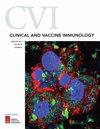Comparisons of the Humoral and Cellular Immune Responses Induced by Live Attenuated Influenza Vaccine and Inactivated Influenza Vaccine in Adults
Q2 Biochemistry, Genetics and Molecular Biology
引用次数: 100
Abstract
ABSTRACT Both live attenuated influenza vaccines (LAIV) and inactivated influenza vaccines (IIV) induce protective immunity against influenza. There is evidence that LAIV induces superior protection in children, whereas IIV may induce superior protection in adults. The immune mechanisms responsible for these differences have not been identified. We previously compared LAIV and IIV in young children of 6 to 36 months of age, and we demonstrated that while both induced similar hemagglutination inhibition (HAI) antibody responses, only LAIV induced significant increases in T cell responses. In the present study, 37 healthy adult subjects of 18 to 49 years of age were randomized to receive seasonal influenza vaccination with LAIV or IIV. Influenza virus-specific HAI, T cell, and secretory IgA (sIgA) responses were studied pre- and postvaccination. In contrast to the responses seen in young children, LAIV induced only minimal increases in serum HAI responses in adults, which were significantly lower than the responses induced by IIV. Both LAIV and IIV similarly induced only transient T cell responses to replication-competent whole virus in adults. In contrast, influenza virus-specific sIgA responses were induced more strongly by LAIV than by IIV. Our previous studies suggest that LAIV may be more protective than IIV in young children not previously exposed to influenza virus or influenza vaccines due to increased vaccine-induced T cell and/or sIgA responses. Our current work suggests that in adults with extensive and partially cross-reactive preexisting influenza immunity, LAIV boosting of sIgA responses to hemagglutinin (HA) and non-HA antigenic targets expressed by circulating influenza virus strains may be an important additional mechanism of vaccine-induced immunity.成人流感减毒活疫苗和灭活疫苗诱导的体液和细胞免疫应答的比较
流感减毒活疫苗(LAIV)和流感灭活疫苗(IIV)均可诱导对流感的保护性免疫。有证据表明,LAIV在儿童中诱导较强的保护作用,而iv可能在成人中诱导较强的保护作用。造成这些差异的免疫机制尚未确定。我们之前比较了LAIV和IIV在6至36个月大的幼儿中的作用,结果表明,虽然两者都诱导了相似的血凝抑制(HAI)抗体反应,但只有LAIV诱导了T细胞反应的显著增加。在本研究中,37名18至49岁的健康成人受试者随机接受季节性流感疫苗接种LAIV或iv。研究了疫苗接种前后流感病毒特异性HAI、T细胞和分泌性IgA (sIgA)反应。与在幼儿中观察到的反应相反,LAIV仅诱导成人血清HAI反应的微小增加,明显低于IIV诱导的反应。在成人中,LAIV和IIV同样只诱导短暂的T细胞对具有复制能力的全病毒产生反应。相比之下,LAIV诱导的流感病毒特异性sIgA反应比IIV更强烈。我们之前的研究表明,由于疫苗诱导的T细胞和/或sIgA反应增加,LAIV可能比iv对以前未暴露于流感病毒或流感疫苗的幼儿具有更强的保护作用。我们目前的工作表明,在具有广泛和部分交叉反应性预先存在的流感免疫的成年人中,LAIV增强sIgA对循环流感病毒株表达的血凝素(HA)和非HA抗原靶点的反应可能是疫苗诱导免疫的重要额外机制。
本文章由计算机程序翻译,如有差异,请以英文原文为准。
求助全文
约1分钟内获得全文
求助全文
来源期刊

Clinical and Vaccine Immunology
医学-传染病学
CiteScore
2.88
自引率
0.00%
发文量
0
审稿时长
1.5 months
期刊介绍:
Cessation. First launched as Clinical and Diagnostic Laboratory Immunology (CDLI) in 1994, CVI published articles that enhanced the understanding of the immune response in health and disease and after vaccination by showcasing discoveries in clinical, laboratory, and vaccine immunology. CVI was committed to advancing all aspects of vaccine research and immunization, including discovery of new vaccine antigens and vaccine design, development and evaluation of vaccines in animal models and in humans, characterization of immune responses and mechanisms of vaccine action, controlled challenge studies to assess vaccine efficacy, study of vaccine vectors, adjuvants, and immunomodulators, immune correlates of protection, and clinical trials.
 求助内容:
求助内容: 应助结果提醒方式:
应助结果提醒方式:


